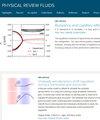Droplet breakup and size distribution in an airstream: Effect of inertia
IF 2.5
3区 物理与天体物理
Q2 PHYSICS, FLUIDS & PLASMAS
引用次数: 0
Abstract
We experimentally investigate the morphology and breakup of a droplet as it descends freely from a height and encounters an airstream. The size distributions of the child droplets are analyzed using high-speed shadowgraphy and in-line holography techniques. We find that a droplet falling from various heights exhibits shape oscillations due to the intricate interplay between inertia and surface tension forces, leading to significant variations in the radial deformation of the droplet, influencing the breakup dynamics under an identical airstream condition. Specifically, the droplet undergoes vibrational breakup when introduced at a location slightly above the air nozzle. In contrast, as the release height of the droplet increases, keeping the Weber number defined based on the velocity of the airstream fixed, a dynamic interplay between the inertia of the droplet and the aerodynamic flow field comes into play, resulting in a sequence of breakup modes transitioning from vibrational breakup to retracting bag breakup, bag breakup, bag-stamen breakup, retracting bag-stamen breakup, and eventually returning to vibrational breakup. Our experiments also reveal that the size distribution resulting from retracting bag breakup primarily arises from rim and node fragmentation, leading to a bimodal distribution. In contrast, bag and bag-stamen breakups yield a trimodal size distribution due to the combined contributions of bag, rim, and node breakup mechanisms. Furthermore, we utilize a theoretical model that incorporates the effective Weber number, considering different release heights. This model accurately predicts the size distribution of the child droplets resulting from the various breakup modes observed in our experiments.

气流中的液滴破裂和大小分布:惯性的影响
我们通过实验研究了液滴从高空自由降落并遇到气流时的形态和破裂情况。我们使用高速阴影成像和在线全息成像技术分析了子液滴的尺寸分布。我们发现,由于惯性力和表面张力之间错综复杂的相互作用,从不同高度落下的液滴表现出形状振荡,导致液滴的径向变形发生显著变化,从而影响了相同气流条件下的破裂动力学。具体来说,液滴在略高于空气喷嘴的位置时会发生振动破裂。相反,随着液滴释放高度的增加,在保持根据气流速度确定的韦伯数不变的情况下,液滴的惯性和空气动力流场之间的动态相互作用开始发挥作用,从而产生了从振动破裂过渡到缩囊破裂、袋破裂、袋-柱破裂、缩囊-柱破裂并最终返回振动破裂的一系列破裂模式。我们的实验还发现,缩囊破裂产生的尺寸分布主要来自边缘和节点的破碎,从而导致双峰分布。与此相反,由于袋、边缘和节点破裂机制的共同作用,袋和袋-雄蕊破裂产生了三态尺寸分布。此外,考虑到不同的释放高度,我们采用了一个包含有效韦伯数的理论模型。该模型准确预测了实验中观察到的各种破裂模式产生的子液滴的尺寸分布。
本文章由计算机程序翻译,如有差异,请以英文原文为准。
求助全文
约1分钟内获得全文
求助全文
来源期刊

Physical Review Fluids
Chemical Engineering-Fluid Flow and Transfer Processes
CiteScore
5.10
自引率
11.10%
发文量
488
期刊介绍:
Physical Review Fluids is APS’s newest online-only journal dedicated to publishing innovative research that will significantly advance the fundamental understanding of fluid dynamics. Physical Review Fluids expands the scope of the APS journals to include additional areas of fluid dynamics research, complements the existing Physical Review collection, and maintains the same quality and reputation that authors and subscribers expect from APS. The journal is published with the endorsement of the APS Division of Fluid Dynamics.
 求助内容:
求助内容: 应助结果提醒方式:
应助结果提醒方式:


